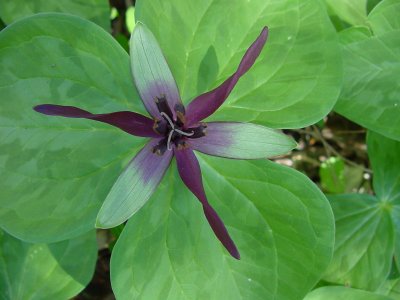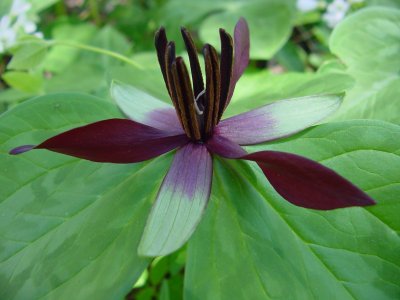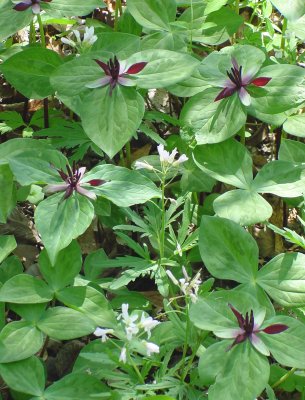
Twisted trillium (Trillium stamineum). The little propeller trillium! I love this one.

Trilliums are among my favorite wildflowers. At a Special Studies class on wildflowers, they told us that there are 18 types of trilliums in Alabama. They didn't name them, but I think that they are:
Trillium catesbaei (Catesby's or Bashful)
T. cuneatum (Little Sweet Betsy, toadshade, wakerobin, etc.)
T. decipiens (Chattahoochee River)
T. decumbens (Trailing)
T. erectum (Red)
T. flexipes (Bent or nodding)
T. lancifolium (Lanceleaf)
T. ludovicianum (Louisiana)
T. luteum (Yellow)
T. maculatum (Spotted)
T. pusillum (Dwarf)
T. recurvatum (Bloody butcher, Recurved sepal)
T. reliquum (Relict)
T. rugelii (Nodding or ill-scented)
T. sessile (Sessile)
T. stamineum (Twisted)
T. underwoodii (Underwood's or longbract)
T. vaseyi (Vasey's)
Many of these are found in very small numbers in Alabama, and are most easily viewed at botanical gardens.
Some older books show cernuum in AL, but this was split into cernuum and rugelii, with rugelii being the southern species.
Two of these are sometimes called "nodding", an example of confusing trillium common names. (I like dealing in latin names with trilliums.)
In most of Alabama, Trillium cuneatum is the common "if you just have one, this is it" trillium.
For lots more info, visit Susan Farmer's excellent collection of Trillium links and photos.
The Trillium book by the Cases is considered the "Trillium Bible" and is full of beautiful photos.

-----
Edited 17 June 2007:
I got a sneak peek at a draft copy of an Alabama vascular flora checklist, and it's slightly different than my list (that I derived mainly from my two Trillium books). T. erectum is not on it, but T. grandiflorum and T. sulcatum are. One of my new local wildflower friends knows a place where the grandiflorum grow (a few counties over) so I know that one is correct.

Nice shots!
ReplyDeleteI always wonder about the function behind a plant's design. Does the propellor twist help attract certain insects? Keep it stable in high winds? Power the covert night flights around the garden?
Trilliums are high on my list of favorites also. Great pics.
ReplyDeleteI'd never seen those before. They are gorgeous.
ReplyDeleteAnother rainstorm again today after beautiful 65 degree weather yesterday. You'll probably get this storm in a day or two. Storms make your pictures more beautiful...they just get me wet.
Beautiful. I've never been to Alabama, but your photos make it look so lovely and lush. I love stopping by here to get an idea of what you see around you. So nicely done.
ReplyDeleteSo strangely beautiful. I've been reading up about them on the web, as there aren't any in Europe. Rather a trying experience, as SO many things are called Trillium - what it is about the word that has appealed to so many companies, foundations, music ensembles, schools...?
ReplyDeleteKaren! I love those images...very nice work. I love how the other colors blend into the green. We're starting to get some color here in KY...I may have to go out shooting soon...
ReplyDeleteAs usual, very pretty!
ReplyDeleteYou are making me want to take a trip to the piedmont of my state. I love the coastal plain, but I sorely miss the variety of spring wildflowers in our piedmont and mountain regions.
ReplyDeleteI haven't been to Alabama in years -- may have to remedy that!
Thanks y'all.
ReplyDeleteJerry - Hee hee. I knew there was a reason besides wildlife that I need one of those motion-activated cameras!
Alabama is nice in that it has a lot of different types of habitats and geological regions. But truthfully, most people just don't notice the little things that make it such a nice place, in my opinion. (I never used to either.) Of course there are lots of bugs and heat and humidity and such that doesn't make it into the pictures. :)
Jean, I think most of our Trilliums do grow well (in gardens) in Europe. Not sure about the name thing... maybe partly because of the trinity aspect of it?
"...bugs, heat, and humidity..." sounds like home to me :-)
ReplyDelete